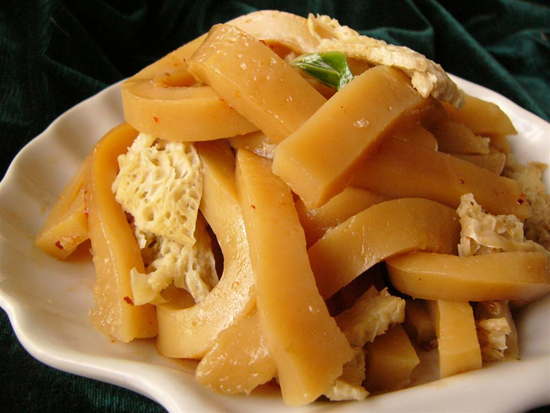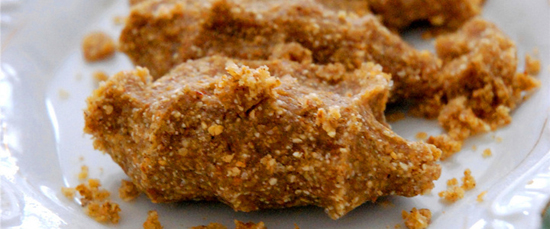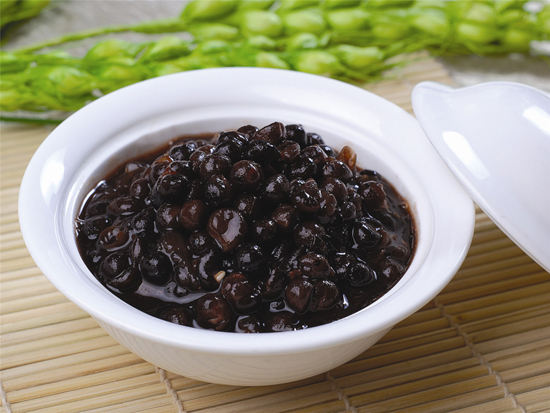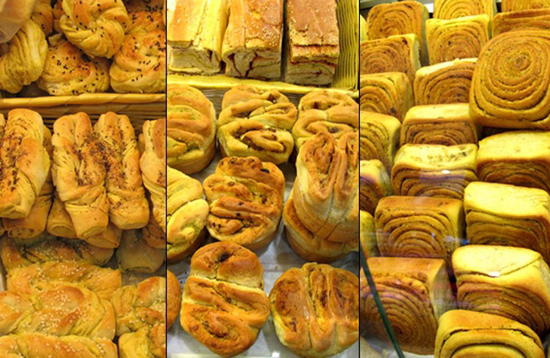Unlike the signature dishes of traditional Gansu cuisine, which tend to be fatty and rich, Gansu-style snacks are characterised by their light, spicy, and sour flavours. They are designed to cool and refresh regardless of the weather, and provide a welcome alleviation from the typically salty and oily signature dishes. From fluffy cakes to afternoon tea, these snacks provide a slice of comfort at any time of the day.
Niangpizi (酿皮子)
This is a popular, cheap, and widely available snack that you’ll find on almost any street corner in Gansu. It’s so widespread that there are as many varieties as there are counties, so be prepared to have your taste buds titillated with the diversity of flavours! The snack is made by first mixing flour with water until it forms a viscous paste. This paste is spread thinly over a steamer, steamed for between 3 to 4 minutes until cooked through, and then cut into thick, juicy strips. The strips are typically served with a tangy garnish made from mustard seeds, garlic, coriander, sesame paste, chilli oil, vinegar, and soy sauce, but this sauce varies from vendor to vendor.
Arguably the most famous type of niangpizi is known as Gaodan Niangpi, which originated from the Liangzhou region. According to local legend, the creator of the snack used to carry his goods in a pair of baskets that he hung high off the ground on a shoulder pole, so the snack was nicknamed Gaodan or “High Shoulder Pole”. Compared to niangpizi of other varieties, Gaodan Niangpi has less elasticity and a slightly greyish-white hue. It is often served with succulent slices of cucumber and crunchy bean sprouts.
Zanba (糌粑)
Zanba or Tsampa is a traditional Tibetan snack that is particularly popular with farmers, Sherpas, and shepherds, as it is easy to carry, provides a much-needed boost of energy, and is cheap to make. You simply take a dollop of roasted highland barley flour and mix it with Tibetan butter tea until the flour starts to bind. You then mould the mixture by hand into a fat oval shape, much like a dumpling. The flour to tea ratio must be relatively exact and it requires some skill to make the perfect zanba, but the result is a fragrant, buttery, and satisfying snack that’s bursting with ethnic flavour. It can be a little dry, so it’s recommended that you wash down a tasty zanba with a cup of tea or a refreshing glass of chang (locally brewed wine made from barley).
Hui Douzi (灰豆子)
This sweet dessert originated from Lanzhou and is made using locally sourced grey peas and red dates. First, the red dates are mashed until they give off a strong and plummy fragrance. Then the peas, dates, and a small amount of water are mixed together and simmered on a low heat until the peas are soft but still retain their shape. The final result is a thick, fruity dessert that is renowned for its unique flavour. Sugar is typically added to the mixture before serving to soften the fruit’s naturally sour tang. In summer, it’s served up cold and is designed to help cool you down in the sweltering heat, while in the winter it’s served hot and is the perfect comfort food to warm you from the inside out. Whether it’s too hot, too cold, or just right, be sure to keep an eye out for any bears before you tuck into this porridge-like snack!
Shaokezi (烧壳子)
Shaokezi is a kind of cake and one of the traditional dishes of the Yugur ethnic minority, a Turkic-speaking people who live almost exclusively in Su’nan Yugur Autonomous County of Gansu province. It is made by first moulding the dough into a flat circle and then roasting it in a stove full of burning dried sheep manure. When the cake has fluffed up and turned a crisp golden brown, it is done and can be removed from the stove to cool. It is normally served on special occasions, such as weddings and festivals, and skilful Yugur bakers have been known to create shaokezi in the shape of flowers, peaches, apples, and all manner of artistic things. After all, if it’s shaped like a fruit, it has to be healthy!
Taste some authentic Gansu Snacks on our travel: Explore the Silk Road in China and Explore “The Good Earth” in Northwest China



